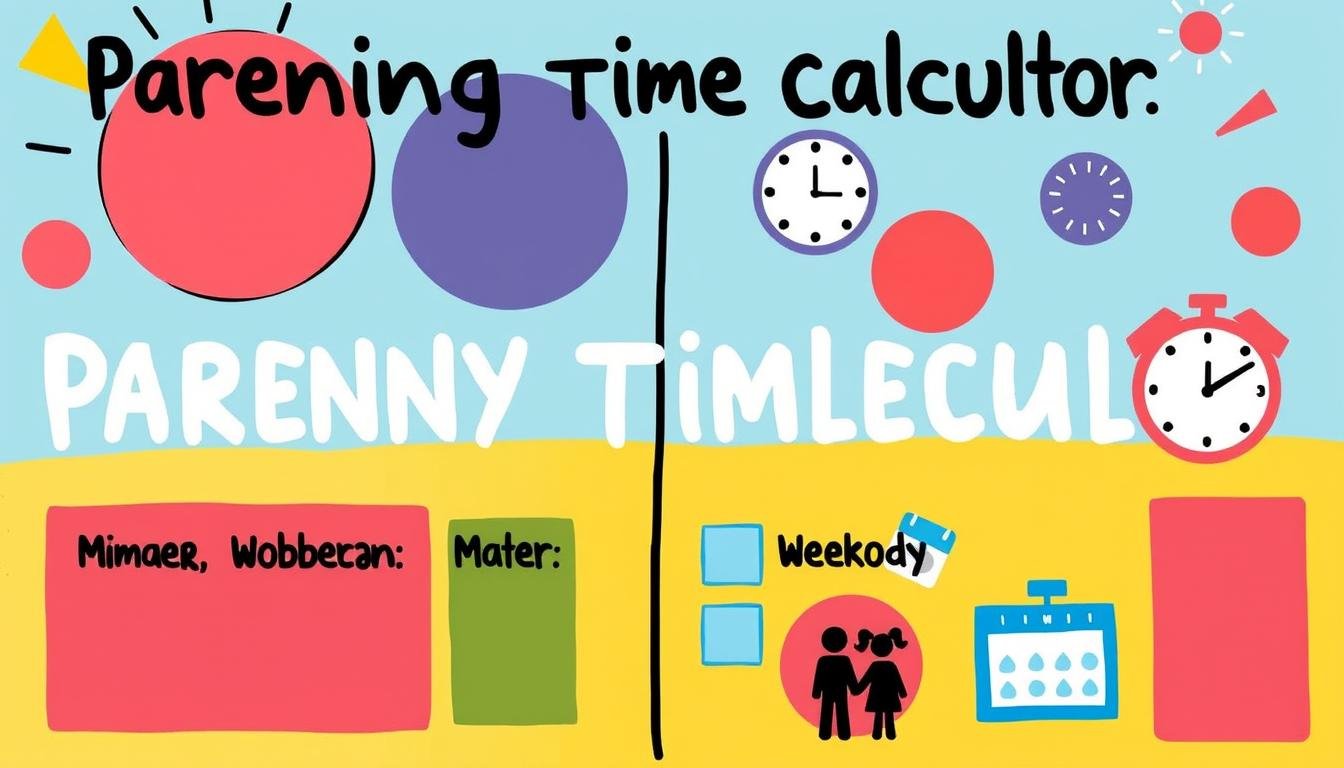Are you having trouble figuring out the best parenting time schedule for your child? You might be thinking about your child’s age, your lifestyle, and how involved you both are. Wondering how to use a parenting time calculator and follow guidelines? For more on parenting time schedules and guidelines, check out the parenting time page.
Co-parenting can be complex. It’s key to tailor parenting time schedules to meet your child’s needs. This can be tough, and about 20% of parents want to change their parenting plans. This shows the need for flexibility due to changing situations or what’s best for the child1. Modern Family Law says every family is unique, making this challenge even harder. But, the more detailed you are, the less likely there will be conflict.
Getting parenting time right is very important. It can affect how much child support you get, which can save you thousands of dollars a year2. A parenting time calculator can help you find the best schedule for your child.
Key Takeaways
- Parenting time schedules should be highly customized to fit the developmental needs of the children.
- Approximately 20% of parents seek modifications to existing parenting plans, indicating a significant need for flexibility due to changing circumstances or best interests of the child1.
- Accurate parenting time figures can significantly impact child support calculations, potentially benefiting individuals by thousands of dollars annually based on state formulas2.
- Using a parenting time calculator can help you determine the best schedule for your child and provide parenting time guidelines.
- Parenting time calculators assist in maintaining compliance with court-awarded timeshares, which is important for keeping good standing in the legal system2.
- Continuous calculations reflect real-time shifts in parenting time based on minor scheduling adjustments, negating the need for repetitive manual recalculations2.
Understanding the Basics of Parenting Time
Creating a co-parenting schedule starts with knowing the basics of parenting time. This time is how much each parent gets to spend with their child. It helps figure out child support3. Shared custody means both parents spend a lot of time with their child. This helps keep the child’s relationship with both parents strong and stable.
A child custody calculator can help figure out how much time each parent should have4. But, every family is different. So, it’s important to think about what’s best for your family. For example, a 2-2-5-5 schedule can help both parents spend quality time with their child.
When making a co-parenting schedule, keep these things in mind:
- Make a schedule that works for everyone
- Keep the schedule flexible for changes
- Use a child custody calculator to plan time5
Understanding parenting time and using tools like a child custody calculator can help. This way, parents can make a schedule that works for everyone3. It’s good for the child’s emotional and psychological health4.
| Parenting Time Schedule | Percentage of Time |
|---|---|
| 2-2-5-5 schedule | 50% |
| Alternate weekends | 25% |
| One week on, one week off | 50% |
How to Calculate Parenting Time: Step-by-Step Methods
To figure out parenting time, you must look at parenting time factors like custody and visitation6. It’s important to find out the parenting time percentage for child support. Modern Family Law says common schedules include Every Other Week, 5-2-2-5, Every Other Weekend, 4-3-3-4, and 2-2-37.
Use a visitation timeshare calculator to find out how much time each parent spends with the child7. This helps you see if one parent has most of the time, if it’s split, or if it’s shared6. For example, if a child spends more than 60% of their time with one parent, that parent has the majority6.
Here are some key points to consider when calculating parenting time:
- Majority of parenting time: more than 60% of the time with one parent6
- Split parenting time: each parent has the majority of parenting time with at least one child6
- Shared parenting time: children spend at least 40% of their time with each parent6
By understanding these concepts and using the right tools, you can accurately calculate parenting time. This ensures a fair custody and visitation arrangement7.
| Schedule | Parenting Time Percentage |
|---|---|
| Every Other Week | 50% |
| 5-2-2-5 | 55% |
| 2-2-3 | 45% |
Essential Tools for Tracking Custody Hours
Managing shared custody arrangements can be easier with the right tools. A parenting time calculator helps track and calculate time with your child. This ensures your co-parenting schedule is fair and accurate. The Custody X Change app is a great tool for this, allowing you to create a schedule and track time8.
Spreadsheet templates are also useful for tracking custody hours. You can customize them to fit your needs. They help you stay organized and keep track of your co-parenting schedule. For example, you can use a spreadsheet to count hours with your child each week, making it easier to figure out your parenting time percentage9.
Paper-based systems are another option for tracking custody hours. They might not be as easy to use as digital tools, but they can work well. Some parents like using a custody calendar to track their time and schedule10.
Finding a system that works for you and your child is key to successful co-parenting. Whether you choose a parenting time calculator, spreadsheet, or paper-based system, the most important thing is fairness and accuracy. This ensures your co-parenting schedule is in the best interest of your child.
| Tool | Description |
|---|---|
| Custody X Change app | Digital tracking app for creating custody schedules and tracking actual parenting time8 |
| Spreadsheet templates | Customizable templates for tracking custody hours and calculating parenting time percentage9 |
| Paper-based systems | Paper-based systems, such as custody calendars, for tracking parenting time and co-parenting schedules10 |
Making Sense of Different Schedule Patterns

Understanding different parenting time schedules is key. You must pick the best schedule for your family. A child custody calculator can help with this. The 80/20 schedule, for example, means one parent has 80% of the time, and the other has 20%11.
This schedule works well when a child needs a stable home base. It’s also good when parents live far apart11.
The 50/50 schedule gives each parent 50% of the time. It’s great for families where both parents are involved equally. On the other hand, a 60/40 schedule gives 60% to one parent and 40% to the other12.
This schedule is useful when one parent has less time during the week. The other parent can then provide more care.
Some variations of the 60/40 schedule include the 4-3 arrangement. Here, one parent has four nights, and the other has three12. This can make both parents have similar quality time with their kids, even with school or daycare time12.
When making a schedule, think about your family’s unique needs. Use a child custody calculator to follow parenting time guidelines13.
Finding a schedule that works for everyone is the goal of co-parenting. By understanding different schedules and using a child custody calculator, you can create a plan that suits your family. This plan will follow the parenting time guidelines13.
The Mathematics Behind Parenting Time Percentages
Figuring out parenting time percentages is all about what’s best for the child. Custody X Change offers a tool to calculate how much time each parent gets with the child14. This helps make sure the child’s needs are met and the custody and visitation plans are fair.
In the U.S., laws about parenting time vary by state. Some states have clear rules, while others let the court decide15. For instance, some states adjust child support if one parent has 25% of the overnights, while others use 30%16.
Here are some examples of parenting time percentages and their corresponding custody and visitation arrangements:
- Alternate weekends: 14%14
- One extended weekend per month: 10%14
- Alternate weekends + half the holidays + two weeks during summer: 18%14
Remember, these percentages can change based on each case’s unique details. The court looks at the child’s age, parents’ work schedules, and home locations when setting parenting time15.
In conclusion, figuring out parenting time percentages needs careful thought about the child’s best interests and custody plans. By using a parenting timeshare calculator and knowing your state’s laws, you can create a fair parenting time schedule14.
| State | Threshold for Child Support Adjustments |
|---|---|
| Arizona | 1% |
| California | 1% |
| Indiana | 14% |
Special Considerations for Holiday and Vacation Time
Creating a co-parenting schedule is key to ensuring both parents spend quality time with their kids. Parenting experts say it’s vital to include holidays and special times in the plan17. Options range from alternating holidays to splitting them in half or assigning specific ones18.
When planning, think about the child’s age, health, and how they feel about each parent19. It’s important to make a holiday schedule that suits everyone. This might mean setting aside certain holidays for each parent or alternating others like Thanksgiving and Christmas17.
Using tools like the Custody X Change app can help make planning easier18. It allows you to organize parenting time, including holidays and vacations. This way, both parents can spend quality time with their kids. By focusing on these details, you can create a schedule that benefits everyone and puts the child first19.
Successful co-parenting relies on good communication and flexibility. By working together and considering each other’s needs, you can make a schedule that works for all. Remember to update your schedule regularly to keep up with your child’s and family’s changing needs18.
Legal Requirements for Parenting Time Documentation
Understanding the legal needs for parenting time documentation is key. Custody X Change says the best way to make a custody schedule is through their app20. This app helps in creating a schedule and tracking time, which is vital for custody and visitation plans. In the U.S., tools like Custody X Change make it easier to figure out parenting time21.
Every state has its own rules for parenting time documents. Some states ask parents to give the court a parenting time schedule. Others want parents to keep a record of their time22. Knowing your state’s rules is important to meet legal standards. By using a child custody calculator and following guidelines, you can make sure your arrangements are fair for your child.
- Accurate record-keeping of parenting time
- Compliance with court orders and state-specific guidelines
- Use of child custody calculator tools to facilitate the calculation of parenting time
By following these steps and using the right tools, you can make sure your parenting time documents are correct and follow the law20. Always remember, the most important thing is your child’s best interests when dealing with parenting time21.
Common Mistakes to Avoid in Time Calculations
When figuring out parenting time percentage, it’s important to steer clear of common mistakes. These errors can cause disputes and impact child support. About 30% of parents might get parenting time wrong, leading to issues with child support and custody23. To avoid these mistakes, using a parenting time calculator can help get the numbers right.
Understanding how to apply the guidelines is key. Learning how to calculate parenting time can make the process easier. Keeping detailed records of parenting time and expenses can also help. This can cut down disputes by 60%23.
It’s also important to watch out for misrepresenting parenting expenses. This can cause a 20% increase in disputes over financial obligations in custody hearings23. By avoiding these mistakes and using tools like a parenting time calculator, you can make the process smoother. For more tips on avoiding common mistakes in child support calculations, check out child support calculation guidance.
By being informed and taking the right steps, you can reduce the chance of errors in parenting time percentage calculations. This ensures a fair arrangement for everyone involved. Remember, accurate calculations are essential to avoid disputes and get the best outcome for your child24.
Adjusting Your Calculations for Different Age Groups
When thinking about parenting time, the child’s age is key. School-age kids, from 5 to 13 years old25, need something different than babies or toddlers. Custody X Change says that 50/50 schedules are good because they let kids spend a lot of time with both parents, which is best for them.
For school-age kids, having a regular schedule is important. This can mean switching weeks, having long weekends, or a 2-2-3 split25. It’s also vital to keep up with their school and social life. The Parenting Teenagers website says that parenting plans should always put the child first.
For younger kids, like infants and toddlers, step-up plans are used. These plans have seven steps that help until the child is 1826. They help parents work together towards equal parenting, making it more likely they’ll get along. By thinking about each age group’s needs, parents can make a plan that’s best for their child and keeps them safe and loved.
- Age and developmental needs of the child
- Consistency and stability in the parenting schedule
- Involvement of both parents in the child’s life
- Flexibility to accommodate changing circumstances
By considering these points, parents can make a plan that fits their child’s needs. This helps keep a strong, positive bond between both parents and their child.
Technology Solutions for Modern Co-Parenting

Managing your co-parenting schedule can be tough. But, the right tools can make it easier. A parenting time calculator helps you figure out parenting time. This makes setting up shared custody arrangements simpler27. You can use online tools to create a schedule that suits everyone.
Online co-parenting apps like 2Houses and Our Family Wizard have cool features. They let you share calendars, message, and track expenses27. These tools keep you organized and help you talk to your co-parent better. Plus, a parenting time calculator can find the best schedule for your child, based on their age and needs28.
When making a co-parenting schedule, think about what’s best for the child. A steady schedule gives them stability and security. This is key for their emotional and mental health27. Use a parenting time calculator to find the best schedule for your child. Then, create a shared custody arrangement that suits both parents.
Technology has many benefits for co-parenting:
- It improves communication with your co-parent
- It makes scheduling and calendar sharing easy
- It helps with expense tracking and management
- It gives you access to a parenting time calculator for the best schedule
With these tools, you can make a co-parenting schedule that benefits everyone. This promotes a healthy and happy relationship between parents and child28.
Making Modifications to Your Parenting Time Schedule
Co-parenting can be complex. It’s key to know how to change your parenting time schedule. Courts usually update plans if there’s a big change, like moving far away or a job change29. Parenting time guidelines help figure out what’s best for your child.
When you want to change your parenting time, it’s important to document it well. A child custody calculator can help figure out how much time each parent gets29. Custody X Change suggests using a parenting timeshare calculator to track time spent with the child29. This makes it easier to adjust as needed.
In some places, like Florida, parenting plans are part of child support orders30. The Title IV-D Standard Parenting Time Plan outlines how much time a child should spend with the parent who owes support30. Knowing these rules is key for your custody and visitation plans.
- Check your current schedule and see where you can make changes
- Use a child custody calculator to figure out each parent’s time
- Keep accurate records with tools like a parenting timeshare calculator
- Talk to your co-parent and agree on changes
By taking these steps and understanding the rules, you can update your parenting time schedule. This ensures your child’s needs come first29.
Conclusion: Mastering Your Parenting Time Calculations
Learning how to calculate parenting time is key for your kids’ well-being and a fair co-parenting setup. With the tools and strategies from this article, you can get good at figuring out parenting time. This way, you can make a schedule that suits your family31.
There’s no single way to handle parenting time. It’s important to be flexible, talk openly with your co-parent, and adjust as your kids’ needs change3132.,
Staying organized, keeping records, and using technology can make calculating parenting time easier. This ensures your parenting time percentage is good for your family3133.,
The main goal is to give your kids a stable, loving home. With the right methods and tools, you can manage your parenting time calculator well. This helps create a custody plan that’s great for your family313233.,,
FAQ
What counts as parenting time?
Why do accurate parenting time calculations matter?
What are the different types of parenting time schedules?
What tools are available for tracking custody hours?
How do I calculate parenting time percentages?
How do I handle special considerations for holiday and vacation time?
What are the legal requirements for parenting time documentation?
What common mistakes should I avoid when calculating parenting time?
How do I adjust my calculations for different age groups?
What technology solutions are available for modern co-parenting?
How do I make modifications to my parenting time schedule?
Source Links
- Parenting Time Calculator | Modern Family Law – https://www.modernfamilylaw.com/calculators/parenting-time/
- Calculate Parenting Time and Overnights Instantly with Software – https://www.custodyxchange.com/topics/software/timeshare-overnight-calculator.php
- Understanding Parenting Time Guidelines: Goals, Rules, & Definitions – https://www.custodyxchange.com/topics/schedules/overview/parenting-time-guidelines.php
- Calculating Shared Parenting Time and Child Support – https://familylawyerab.com/child-support/calculating-shared-parenting-time-and-impact-on-child-support/
- 3 Factors That Impact Your Parenting Time Calculations – https://www.custodyxchange.com/help/calculations/factors.php
- Step 3: Determine the parenting arrangement – https://www.justice.gc.ca/eng/rp-pr/fl-lf/child-enfant/guide/step3-etap3.html
- How Does it Work? Why Would You Choose It? – https://www.custodyxchange.com/topics/schedules/50-50/2-2-3.php
- Track How Much Parenting Time You Actually Get – https://www.custodyxchange.com/topics/software/tracking-time.php
- Calculating Child Timeshare (Custody Percentage) – https://cristinlowelaw.com/calculating-child-timeshare-custody-percentage/
- Alimentor 2: Custody Calendar App for iPhone, iPad and Mac – https://alimentor.org/
- 80/20 Custody & Visitation Schedules: Most Common Examples – https://www.custodyxchange.com/topics/schedules/80-20/5-examples.php
- 60/40 Custody Schedules: Examples, Factors, and Expert Tips – https://www.ourfamilywizard.com/blog/60-40-custody-schedules
- How to Make Your Parenting and Visitation Schedule – https://www.custodyxchange.com/topics/schedules/overview/schedule.php
- Table for Calculating Parenting Time Percentage for Support – https://farzadlaw.com/child-support/calculating-parenting-time-percentage
- PDF – https://www.alacourt.gov/docs/draftarticle.familylawquarterly.pdf
- V – https://www.irp.wisc.edu/wp/wp-content/uploads/2018/06/Brown_Brito_Task11.pdf
- Making Your Holiday Visitation Schedule – https://www.custodyxchange.com/topics/holidays/making-holiday-schedule.php
- Child custody and parenting time | California Courts – https://selfhelp.courts.ca.gov/child-custody
- Child Custody Holiday Visitation Schedule (With Examples) – https://btlfamilylaw.com/child-custody-holiday-visitation/
- PDF – https://csc.georgiacourts.gov/wp-content/uploads/2023/06/GA_parentingtimeJune22.pdf
- Microsoft Word – GA cover page May 11 2023 – https://csc.georgiacourts.gov/wp-content/uploads/2023/05/GA_time_sharingMay14revised.pdf
- Parenting Time – A Child’s Right – https://www.njcourts.gov/sites/default/files/forms/11904_parenting_time.pdf
- Don’t Use These 8 Dirty Tricks To Win Child Custody – https://www.custodyxchange.com/topics/custody/advice/dirty-tricks-to-win-custody.php
- Common Mistakes to Avoid When Calculating Child Support | Bentley, Kopecki, Smith, P.C. – https://bentley-law.com/blog/common-mistakes-to-avoid-when-calculating-child-support/
- School Age Child Parenting Plans & Custody Schedules: What is Best? – https://www.custodyxchange.com/topics/custody/ages/school-age-child.php
- Adjusting Custody Time as Kids Grow – https://www.custodyxchange.com/topics/plans/overview/step-up-parenting-plan.php
- The Ultimate Guide to 50/50 Parenting Plans – Modern Family Law – https://www.modernfamilylaw.com/resources/ultimate-5050-parenting-plan-guide/
- What Does a 80/20 Custody Schedule Look Like? A Guide for Parents – https://www.2houses.com/en/blog/what-does-a-80-20-custody-schedule-look-like-a-guide-for-parents
- Modifying Your Parenting Plan, Schedule or Child Support: 2 Ways – https://www.custodyxchange.com/topics/custody/steps/modify.php
- Florida Dept. of Revenue – Parenting Time Plans – https://floridarevenue.com/childsupport/parenting_time_plans/Pages/default.aspx
- Common Parenting Time Schedules | Hello Divorce – https://hellodivorce.com/parenting/common-parenting-time-schedules
- equal parenting time formula calculation – http://kschildsupportforum.com/kansas-child-support-guidelines/equal-parenting-time-formula-calculation/
- Child Support Calculations – https://childsupporttraining.com/








0 responses to “Parenting Time Calculations Made Easy”
Is it just me or does anyone else feel that parenting time calculations take away the spontaneity and joy of parenthood?
Parenting isnt about spontaneity, its about commitment, discipline and consistency. Time calculations are crucial!
Interesting read, but wouldnt a dedicated app for parenting time calculations simplify this process even more? Just a thought.
Isnt it ironic that we need step-by-step methods & tools to track our own time with kids? What happened to natural parenting? Thoughts?
Natural parenting died with the advent of 24/7 work culture. Its survival, not irony.